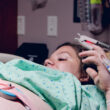If you are pregnant, there is a great chance that your OB/GYN or a nurse will ask you what form of contraceptives you’re going to use after you deliver. If you’re planning on nursing your baby, you can tell them with confidence that breastfeeding is your method of “birth control,” along with a fertility awareness method (FAM).
Common questions about using breastfeeding for birth control
Fertility awareness while breastfeeding may sound counterintuitive to some women, because when you’re breastfeeding, your cycles usually change and the observable signs of fertility are affected. That’s why women considering using breastfeeding as birth control have questions like:
- Is breastfeeding alone an effective method of natural birth control?
- Can I still be fertile and get pregnant while I’m breastfeeding?
- Can I chart my cycles accurately enough to know if I’m fertile or not while I’m breastfeeding?
- Does my current method of fertility awareness or natural family planning (NFP) still work while I’m breastfeeding or will I need to change what I’m doing?
- Where can I go for reliable information on breastfeeding, fertility, and family planning?
This article is not a scientific white paper on the extensive topic of using breastfeeding for family planning, but an effort to answer the above questions in a succinct way and to guide you to additional useful, evidence-based information on the subject.
1. Is breastfeeding an effective natural birth control?
Yes, breastfeeding does affect your fertility, and therefore under some specific conditions, breastfeeding alone can be an effective form of birth control/pregnancy spacing. Lactational Amenorrhea is a complicated-sounding term used to describe the connection between breastfeeding and the continued absence of periods (and fertility). Ecological Breastfeeding (EBF) and Lactational Amenorrhea Method (LAM) are two evidence-based methods of family planning that involve specific conditions for breastfeeding. Both methods have been proven to be highly effective when their respective required conditions are met, and both are widely used to postpone a pregnancy.
Here are a few encouraging statistics about LAM and EBF:
- A 1997 study of LAM involving 519 sexually active women in 11 sites throughout the world showed a 98% success rate at preventing pregnancy [1].
- Ecological Breastfeeding reports a 0% chance of pregnancy for first 3 months, 1% chance for the next 3 months, and 6% chance after six months (assuming no abstinence, no fertility charting at all, and that the mother’s cycles haven’t yet returned) [2].
Keep in mind, too, that these family planning methods are accomplished without contraceptives. That means they do not require putting any chemicals or devices into (or on) your body to be effective! However, if you’re not following the LAM or EBF criteria, or if you simply prefer additional insurance against pregnancy, you should be on the lookout for the signs of your body’s cycle returning, which formal training in a FAM or method of NFP can equip you to do.
2. Can I still be fertile and get pregnant while I’m breastfeeding?
Yes! You absolutely can still get pregnant while breastfeeding if you are not following the conditions set for by LAM, EBF, or your chosen FAM or method of NFP. For instance, if you’re not feeding at the breast exclusively (or nearly exclusively) and use supplemental bottles of formula or pumped milk, and/or start early feedings of solids to your baby, there is a much higher chance that your fertility will come back within six months. And this is important: Every woman, regardless of how she feeds her baby, will be fertile before her period returns, because a period is always preceded by ovulation. So it is highly beneficial to begin charting again as soon as you can after your baby is born, so that you can catch that first postpartum ovulation (and know when to expect your first postpartum period). You can begin charting your signs of fertility with your chosen method of NFP or FAM from the beginning after delivery of your baby, once bleeding stops and lochia lessens.
3. Can I chart accurately enough to know if I’m fertile or not while I’m breastfeeding?
Definitely. We surveyed a few natural family planning (NFP) teachers and this is what they had to say about fertility and charting while breastfeeding:
“I’ve taught many breastfeeding women and they have quickly and confidently learned their days of fertility and infertility,” said Tina Luther, teacher of the Creighton FertilityCare method. “While breastfeeding, there is (typically) not a menstrual period, so it’s a continuous chart. Women chart what they see—their most fertile sign at the end of the day. So we teach them how to discern their days of fertility.”
“The best way to answer the breastfeeding ladies is to tell them that fertility signs can always be charted, but you need to know what you are looking for,” says Cathy Nix, teacher of the Sympto-Thermal Method with Couple to Couple League. “The return to fertility is signaled by the presence of [cervical] mucus and the [basal body] temperature sign. At the first sign of mucus, it is recommended that a woman start to chart again and take her temp.”
The Billings method, another widely used fertility awareness method, offers a similar recommendation on their website: “When a woman is breastfeeding she remains infertile for a variable time. During this time she experiences, at the vulva, either a continuing sensation of dryness, or an unchanging discharge. The appearance of blood, or any change in the mucus or sensation alerts her to the possibility of her returning fertility.”
4. Does my current method of fertility awareness or natural family planning still work while I’m breastfeeding or will I need to change what I’m doing?
As mentioned above, FAM and NFP methods have individual processes to help you observe and interpret the signs of your fertility with a high degree of accuracy, and many have specific protocols to follow while postpartum and/or breastfeeding. If you haven’t learned a method yet, now is a great time to start—and to benefit from the pregnancy prevention efficacy rates, you must learn from a certified instructor in your chosen method. Some methods even have extensive classes specifically geared towards the postpartum period, which will teach you more about LAM and EBF. And if you choose not to follow LAM or EBF criteria, most methods will teach you specific protocols to follow in order to manage and chart the return of your fertility. Most of the major methods of NFP and FAM will help you with the specifics of charting, especially how to identify true cervical mucus after childbirth (the notable exception of which is the ClearBlue Fertility Monitor-based Marquette Method, which encourages mucus monitoring, but does not require it).
Another good reason to consider methods of NFP or FAM for postpartum family planning, compared with conventional forms of birth control, is that hormonal contraceptives can have a negative impact on breast milk production, supply, and duration. This problem seems more common with estrogen-containing combination pills (which is why the “mini-Pill,” i.e., the pill that only contains progestin, is recommended for new mothers who desire to breastfeed), but some women have reported similar issues with progestin-only pills as well. It is also likely that some small amount of the synthetic hormones contained within birth control pills passes through breast milk to the baby (although it is unknown what—if any—effect this may have on the baby).
5. Where should I go for reliable information on breastfeeding, fertility, and family planning?
If you have a FAM or NFP teacher already, you should talk to them while you are pregnant, so that you will be prepared to chart postpartum. If you don’t already have a method or an instructor, or want to learn more about breastfeeding and fertility, here are a few good sources of information:
Books:
- The Womanly Art of Breastfeeding (note: general breastfeeding guidance)
- The Garden of Fertility: A Guide to Charting Your Fertility Signals to Prevent or Achieve Pregnancy–Naturally–and to Gauge Your Reproductive Health
- The Seven Standards of Ecological Breastfeeding: The Frequency Factor
- Breastfeeding and Natural Child Spacing
Studies:
- Multicenter study of the Lactational Amenorrhea Method (LAM): I. Efficacy, duration, and implications for clinical application
- Postpartum contraception: The lactational amenorrhea method
- The Lactational Amenorrhea Method (LAM): A postpartum introductory family planning method with policy and program implications
- The efficacy of the lactational amenorrhea method (LAM) among working women
Personal testimonies about breastfeeding and fertility:
- “My Experience Practicing Ecological Breastfeeding”
- “Fertility Awareness in the Life of a Breastfeeding Mom”
To learn more about the different methods of FAM or NFP, click here.
To find an instructor of FAM or NFP, click here.
Empowering yourself against the postpartum contraception push
We’ve heard stories from mothers who describe how hospital staff would push the Pill or the IUD on them a little before or after they had delivered. Women have even shared with us how they’ve been pressured to have their tubes tied after delivery! This push toward contraception or sterilization so close to the emotionally fraught time of delivery can be quite insensitive, distasteful, and even unethical. Fortunately, women can empower themselves with the knowledge of fertility awareness before they deliver, so that they can better advocate for their own individual needs and family planning desires postpartum. And if your doctor or nurse starts arguing with you and tries to discourage you from using a FAM postpartum, you can refer them to this article! Even if they don’t trust you, know that you can trust yourself, when you have all the information needed to effectively practice fertility awareness postpartum. Don’t let promoters of chemical methods of birth control intimidate you. You and your baby deserve better.
References:
[1] Labbok M, Hight-Laukaran V, Peterson A, Fletcher V, von Hertzen H, Van Look P. Multicenter study of the Lactational Amenorrhea Method (LAM): I. Efficacy, duration, and implications for clinical application. Contraception. 1997;55(6):327-336. doi:10.1016/s0010-7824(97)00040-1
[2] Bonyata K. Breastfeeding and Fertility • KellyMom.com. KellyMom.com. https://kellymom.com/ages/older-infant/fertility/#LAM. Published 2020. Accessed December 17, 2020.
When this article refers to fertility awareness methods (FAM), or natural family planning (NFP), we are referring to Fertility Awareness-Based Methods, evidence-based methods of cycle charting which can be used as effective forms of natural birth control when learned from a certified instructor.
This article was originally published on December 21, 2014 as written by Natural Womanhood CEO and Co-founder Gerard Migeon. It has since been updated by Natural Womanhood to offer more resources. Last updated December 17, 2020.
Additional reading:
Does Breastfeeding Prevent You From Getting Pregnant?
The Problem with Offering Tubal Ligation in the Delivery Room
How breastfeeding is eerily similar to fertility charting
What’s the Best Postpartum Fertility Awareness-Based Method?
Good and Bad News Concerning the LAM Method During the Postpartum Period







